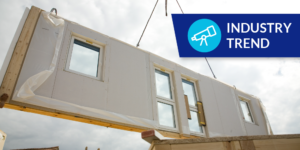
With recent developments in the burgeoning modular homes market, reports say off-site building could cut the cost of residential construction by up to 20%. And while modular building may help cut costs on materials and save time on construction, it could mean a serious shift in job distribution across the residential sector — as well as other disruptions in the field.
With modular building, portions of homes are constructed in factories with the use of assembly lines. These modules are then transported to the home’s plotted location and assembled by a crane.
According to Ken Semler, President-Elect of the Modular Home Builders Association, the build process can take only a few weeks, and assembly on-site can be finished in as little as several hours.
And companies that offer these services are popping up everywhere: Semler’s factory is just one of many that built 24,000 homes last year.
According to TIME, the number of builders who plan to use modular components on at least portions of a residential structure has increased: Roughly 25% of builders surveyed in September 2020 said they planned to use a type of modular roofing going forward, compared to just 15% who said that before the pandemic.
“I think the perfect storm of rising material costs and shortage of labor means that modular’s moment is here,” Semler told TIME. Though the outlook seems optimistic, there may be drawbacks to this innovative construction method.
“I think the perfect storm of rising material costs and shortage of labor means that modular’s moment is here.”
Ken Semler, President-Elect of the Modular Home Builders Association
Modular home building has pros and cons for residential contractors
Semler argued that modular home building carries numerous benefits for contractors, including better working conditions and the ability to build in a much more comfortable environment.
“A climate-controlled factory is a much easier place to build,” while remote plots of land often come with “unpredictable weather conditions,” he said.
Related coverage: Job Expenses for Contractors Skyrocket in 2022
The construction industry’s labor shortage has reached “crisis level,” and many companies are in dire need of skilled workers.
It’s likely that the option to perform work in more comfortable conditions could be attractive to future workers. Just this summer, an Alabama heat wave affected a construction site, giving several workers severe heat exhaustion. A temperature-controlled factory could eliminate concern regarding environmental hardship on workers, opening the doors for future employees.
The Dothan, Alabama job site workers were able to pour only five yards of concrete at a time and needed an abnormal number of breaks due to exhaustion. Modular home building, however, is efficient in multiple ways: Not only is it reportedly easier to complete work in a climate-controlled facility, but these jobs actually require fewer workers and are able to be finished faster.
“Off-site manufacturing can reduce the amount of time it takes to frame a home by 75%,” Ryan Marshall says. Marshall is the CEO of PulteGroup, an off-site manufacturing company. “The factory’s use of robotic saws and nailers helps build homes more precisely. Modular also helps the company do more with fewer workers.”
Another current industry struggle is the constant fluctuation of the supply chain and increases in material costs. Utilizing this cost-effective method could make it easier to obtain materials that have been getting more and more expensive, and may ease the minds of contractors dealing with material budget issues.
According to Semler, the icing on the cake is that these homes can be built in just several weeks in a factory, and can then be transported to the structure’s final location and assembled in as little as a few hours.
But modular home building may not be the answer for all, and it may take a toll on traditional contractors’ businesses.
There’s always the possibility that modular home building will change the value and credibility of traditional construction. Homes built off-site in a factory, though appealing to buyers with their low price tags, could threaten the livelihood of contractors building homes in the traditional method.
Lori Griffin Schubert, a customer of Apex Homes and a recent modular home buyer, told TIME about the immense cost difference between her options.
“Schubert and her husband ended up paying $165 a square foot for their modular home, compared to the $400 per square foot they were getting quoted from on-site builders,” the magazine reported. On-site building contractors could see this trend continue, and there’s a chance it could affect their businesses and livelihood if off-site building remains so inexpensive.
For contractors, switching over to this form of construction could be a huge endeavor, and to be successful, there would need to be a lot of time, money, energy, and labor invested in the transition. Some of these factories have not survived financially, and others couldn’t win over customers with their alternative building methods.
The question on everyone’s minds: does modular building require an entirely new set of skills? Tech-based positions are already abundant and it’s hard enough to fill those. Workers with traditional building skills may find themselves needing to learn a lot more to work for a company focused on modular.
If home buyers are thinking about going modular, traditional building contractors may notice changes in the industry, and preparedness is key. But Semler says companies can hire new workers with limited experience and train them to complete one task, as the process uses assembly lines.
If home buyers are thinking more and more about going modular, traditional building contractors may notice changes in the industry, and preparedness is key. Off-site home building could offer promising opportunities for contractors, but only time will tell how the pieces will come together.